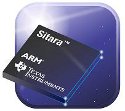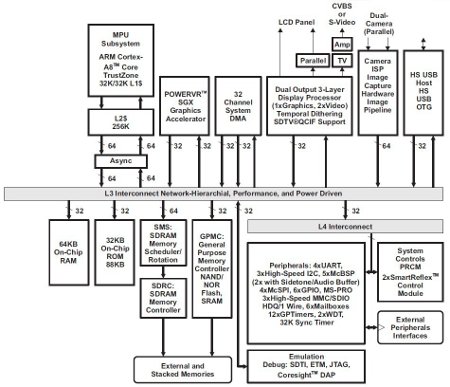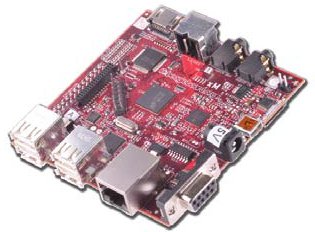TI spins 1GHz ARM Cortex-A8 SoC
Jun 7, 2010 — by Eric Brown — from the LinuxDevices Archive — 46 viewsTexas Instruments announced two new 45nm-fabricated processors including 1GHz ARM Cortex-A8 cores and performance of up to 2000 Dhrystone MIPS. The AM3703 and Open GL graphics-accelerated AM3715 are descendants of TI's OMAP35x line, while an enhanced version of the AM3715 will be part of the BeagleBoard-xM development board that was also announced today.
 Available in 1GHz, 800MHz, and 600MHz versions, the AM37x system-on-chips (SoCs) offer 40 percent faster performance — and up to 30 percent lower power consumption — than the 500MHz Sitara AM35x system-on-chips (SoCs) announced in October, says Texas Instruments (TI). This makes the AM37X suitable for portable, battery-powered devices, as well as for the broad arrray of embedded applications supported by the earlier Sitaras, says the company.
Available in 1GHz, 800MHz, and 600MHz versions, the AM37x system-on-chips (SoCs) offer 40 percent faster performance — and up to 30 percent lower power consumption — than the 500MHz Sitara AM35x system-on-chips (SoCs) announced in October, says Texas Instruments (TI). This makes the AM37X suitable for portable, battery-powered devices, as well as for the broad arrray of embedded applications supported by the earlier Sitaras, says the company.
Applications are said to include industrial automation, automotive navigation, smart displays, and building automation. Portable data terminals and portable medical devices are also cited.
The SoCs are not, however, targeted at smartphones, where TI's flagship 600MHz OMAP3430 is quickly losing ground to the more powerful 1GHz Qualcomm Snapdragon. Here the dual-core, Cortex-A9 based OMAP4 is expected to compete once it begins shipping in volume later this year.

TI AM37x block diagram
(Click to enlarge)
No direct speed comparisons were offered between the 1GHz AM37x and the OMAP35x processors, the fastest of which — the OMAP3530 Rev E — runs at 720MHz and is claimed to offer 1400 MIPS performance. By comparison, the AM37x models, which are manufactured with 45-nanometer (nm) processes instead of the 65nm process used for the OMAP35x, are said to offer 2000 MIPS performance. Like the OMAP3x SoCs, the Soc also offers an ARM Neon instruction set co-processor.
The AM3715 and AM3703 appear to be identical except for the AM3715's inclusion of the Open GL ES 2.0 2D/3D graphics accelerator. Both SoCs offer an LCD video display subsystem and a camera interface subsystem, says the company.
I/O includes USB OTG and Host interfaces, five serial ports, four McSPI serial ports, and three I2C controllers, says TI. Other I/O is said to include MMC/SD, as well as UARTs and GPIO. No Ethernet support appears to be provided, but as the new BeagleBoard-XM shows, designers can work around that by offering Ethernet via USB (see farther below).
Power consumption on the AM37x is said to be slightly higher than with the earlier Sitara SoCs. The company claims that the SoC offers 570mW typical consumption when clocked to 600MHz version.
Code compatibility with Sitara AM35x, OMAP35x
The AM37x SoCs are code compatible with both the OMAP35x and Sitara AM35x processors, says TI. Pin-to-pin compatibility is offered between the AM3715 and AM3703, but not claimed with the four low-end, Sitara-branded ARM9 processors announced in April. (These industrial-focused AM1808, AM1806, AM1707, and AM1705 processors are notable for their programmable real-time unit (PRU), enabling customizable I/O.)
Like the OMAP35x platform, the Sitara AM37x targets a wide variety of products and customers, ranging from start-ups to tech giants.
"These are the first broadly available 1GHz Cortex-A8 processors, open to business for all customers," said Russell Crane, Sitara marketing manager in a recent briefing with LinuxDevices.
Crane touted the ability to start with a fairly simple low-cost device design using the AM35x before moving up to the AM37x. "You can easily upgrade to the AM37x to add improved graphical interfaces and portability," he said.
Specifications listed for the Sitara AM3715 and AM3703 include:
- Core — 45nm-fabricated ARM Cortex-A8 clocked at 600MHz, 800MHz, or 1GHz; Neon SIMD co-processor
- Cache — 32KB instruction cache and 32KB data cache (both 4-way set associative)
- Memory interfaces:
- SDRAM controller 16/32-bit with 1GB address space
- General Purpose Memory Controller (GPMC) with 16-bit wide multiplexed address/data bus; glueless interface to NOR flash, NAND flash, SRAM, and pseudo-SRAM
- System Direct Memory Access (SDMA) controller (32 logical channels)
- Display — Subsystem with LCD controller and dual 10 bit DAC's
- Camera interface — Camera Image Signal Processing (ISP) with CCD and CMOS imager interface
- I/O:
- 5 x multi-channel buffered serial ports
- 4 x Master/Slave Multichannel Serial Port (McSPI)
- USB OTG
- USB Host
- HDQ/1-Wire interface
- 4 x UARTs
- 3 x I2C controllers
- 3 x MMC/SD
- JTAG, ETM, and SDTI test interfaces
- 12 x General Purpose timers
- 3 x watchdog timers
- Sync timer
- Up to 188 General-Purpose I/O (GPIO) pins
- Power:
- 1.8-V I/O and 3.0-V (MMC1 only)
- 0.9-V to 1.2-V adaptive processor core voltage
- 0.9-V to 1.1-V adaptive core logic voltage
- 570mW typical power consumption (@ 600MHz)
- Packages — 515-pin s-PBGA (both CBP and CBC suffix); 423-pin s-PBGA package (CUS Suffix)
EVM offered with Linux BSP, and Android is coming soon
Development on the Sitara AM3715 is supported not only by the BeagleBoard-xM, but by a more fully featured TI TMDXEVM3715 evaluation module (EVM). According to Crane, the current Linux BSP (board support package) will be followed by a Windows CE BSP in the third quarter. An Android version will come "relatively soon," he added.
The current Linux version offers a BSP based on Linux kernel 2.6.32, and provides a graphical user interface, graphics, applications, demonstrations, and development utilities, says TI.
Next up: A video-enhanced Sitara DM3730
In our briefing, TI's Crane noted something we had already discovered in part from BeagleBoard.org late last month in its BeagleBoard-xM announcement. The community hardware group spilled the beans that the new version of the hobbyist development board will offer a TI SoC called the Sitara DM3730. Based on the AM3715, the DM3730 will add a video DSP, much like that offered by the OMAP3530 SoC incorporated in the original BeagleBoards.
With the help of the faster 1GHz clock rate, among other enhancements, the DSP will enable more advanced video processing than available with the OMAP3530, said Crane, who did not offer any further details. The initial AM3715 and AM3703 will support "some version of D1 resolution," he added.
BeagleBoard-xM launches
The DM3730 will not be initially available for the BeagleBoard-xM, which was formally announced today by BeagleBoard.org and distributor Digi-Key. Instead, BeagleBoard-xM customers can get started with an AM3715, and then swap up for the DM3730 later in the third quarter, according to TI.

BeagleBoard-xM
Availability
The AM3715 and AM3703 processors are available now for sampling, and are priced at $26 for the AM3715 and $22.50 for the AM3703 in 1,000 unit quantities (1ku), says TI. The TMDXEVM3715 evaluation module (EVM) is available for Linux now for $1,495, and a Windows CE version should be available in the third quarter, says the company. An Android BSP is also said to be in the works.
More information, including TI's usual excruciatingly in-depth (but highly welcome) datasheets should be available here.
This article was originally published on LinuxDevices.com and has been donated to the open source community by QuinStreet Inc. Please visit LinuxToday.com for up-to-date news and articles about Linux and open source.